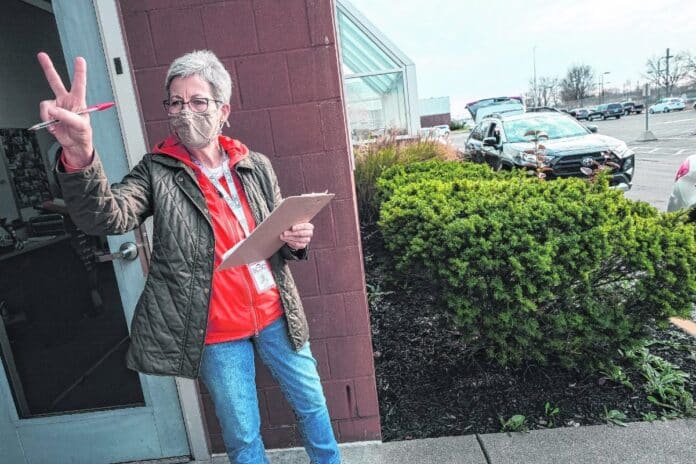
Local food pantries say they continue to see increasing numbers of people seeking help with groceries even after a record surge in demand earlier this year when federal unemployment aid expired.
Last month, Love Chapel served about 4,400 people, including about 1,050 families, which is an increase of 250 people since August and more than 1,350 since July, said Kelly Daugherty, Love Chapel executive director.
The organization has seen an increase in demand each of the past four months, but the most dramatic increase so far was in August after $600 in weekly federal unemployment aid expired.
Currently, Love Chapel is seeing “a lot of new folks,” especially last month and during the early part of this month, Daugherty said.
[sc:text-divider text-divider-title=”Story continues below gallery” ]Click here to purchase photos from this gallery
“That’s troubling to me, that we’re seeing new folks that are now in a situation where they’re hurting,” he said.
Love Chapel, however, is not the only food pantry operating in Columbus that has seen an increase in demand over the course of the pandemic.
Indianapolis-based Gleaners Food Bank of Indiana held a food distribution at Columbus Municipal Airport on Nov. 11 with enough food for 550 families, said Becky Voelz, a local service manager at Gleaners Food Bank of Indiana.
But they ran out of food in about 30 to 45 minutes and had to turn people away, Voelz said.
“It was not a fun time,” she said. “The worst thing to say is, ‘I’m sorry, we’re out of food.’”
The Salvation Army, for its part, is continuing to see higher-than-normal demand for food last month, and officials are concerned about “being able to keep up with the supply and demand,” said pastor and administrator Amy Tompkins.
The organization has been seeing about 30 to 50 new people seek help with groceries each month and served over 1,100 people in October, said Nancy Johnson, social services coordinator at the Salvation Army.
The non-profit typically serves 700 to 900 people per month.
“With the uncertainty of what’s happening, yeah, I do expect (increased demand) to continue,” Tompkins said.
The increased need for food assistance in Bartholomew County comes as millions of people around the country who have been thrown out of work because of the COVID-19 pandemic are struggling to afford the basics.
Experts fear that the economic upheaval will erase progress made on food security in the United States since the Great Recession, according to wire reports. It took about a decade for food insecurity levels to return to pre-Great Recession levels, according to the U.S. Department of Agriculture.
The pandemic, however, is projected to push food insecurity well beyond levels seen during the Great Recession, placing an additional 17 million people in the United States, including 7 million more children, at risk of going hungry, according to Feeding America, a nationwide association of 200 food banks and 60,000 food pantries.
Food insecurity is described as a lack of access to enough food for an active, healthy life, according to the U.S. Department of Agriculture.
Feeding America projects that food insecurity will dramatically increase in Bartholomew County this year due to pandemic, with one out of every six residents at risk of going hungry, as well as nearly one out of every four children.
By comparison, just over one out of every 10 Bartholomew County residents were food insecure in 2018, including nearly one out of six children, according to the latest figures available from Feeding America.
“It looks like the pandemic is increasing, or the number of those testing positive is increasing, which means there will continue to be a need there,” Voelz said. “Because if you’re positive, you have to quarantine. Those around you have to quarantine, which means that you can’t go to work or school. It’s like a never ending cycle.”
Beyond the expected increase in need, some of the biggest challenges local food pantry operators are facing include volunteers, who tend to be older and more likely to suffer severe illness from COVID-19.
“Some of us are getting tired and rotating,” Tompkins said. “Volunteers is one thing that we’re looking for to just give some of our people who’ve been non-stop since the beginning a little bit of a break.”
Daugherty said Love Chapel has seen regular volunteers increase to 135, but that’s still lower than the 200 the organization had last year.
Additionally, Love Chapel’s supply of food is currently at its lowest level so far this year, but officials said they are confident they can meet demand.
“Our stock in the pantry is as low as it’s been this year,” Daugherty said. “It’s not dangerously low, and I feel comfortable that we’ll be able to meet needs. …But there’s truly nothing that we wouldn’t take at this point in time, even canned goods, canned fruits, canned vegetables, as well as any of the shelf items like beans, rice, pasta, spaghetti, that kind of thing.”
Gleaners saw an increase in volunteers at its food distribution in Columbus earlier this month, Voelz said.
“Having the food to give out is wonderful, but if we don’t have anybody to help us put it in cars, then we’re kind of stuck,” Voelz said.
In the meantime, Republicans and Democrats in Congress have remained gridlocked on a new round of pandemic aid as Washington navigates the extraordinary crisis with the nation’s health and economic security at stake.
Through July, people out of work amid the coronavirus pandemic were receiving $600 a week in federal aid on top of their state unemployment benefits. For many recipients, the $600 federal check exceeded their state benefits and kept them afloat as the economy crumbled.
Even food pantries that have not yet experienced a dramatic increase in demand, such as Community Center of Hope, are anticipating an increase as the pandemic progresses.
“We thought there would be a bigger need earlier than what there has been so far,” said Chelsea Warriner, executive director of Community Center of Hope. “I think we anticipate it. We just haven’t seen a huge increase yet.”
Without action from Congress, charitable groups worry the food insecurity will continue to worsen across the country.
But with the prospects of additional federal aid looking dim, some local food pantries are bracing for additional surges in demand in the months to come.
“I think next year is going to be even worse,” Daugherty said. “I think there’s going to be more demand. …Until we get a vaccine out there, we’re probably going to continue to be looking at record numbers or near record numbers every month.”
[sc:pullout-title pullout-title=”Where to find help” ][sc:pullout-text-begin]
- Human Services, Inc. — Provides emergency assistance that is income-based. 4355 E. County Road 600N, Columbus, IN 47203. Contact: 800-296-8026 or (812) 372-8407.
- Indiana National Guard Family Assistance Program — Provides assistance to active duty Guard families or veterans of any branch. 711 N. Pennsylvania St., Indianapolis, IN 46204. Contact: 800-237-2850, Ext. 72694.
- Salvation Army Corps of Bartholomew County — Provides emergency assistance, when funding is available. 2525 Illinois Ave., Columbus, IN 47201. Contact: (812) 327-7118.
- Lincoln Central Neighborhood Family Center — Assistance provided for residents of LCNF service area, only when other assistance is exhausted. 1039 Sycamore St., Columbus, IN 47201. Contact: (812) 379-1630.
- Love Chapel. 292 Center St., Columbus, IN 47201. Contact: (812) 372-9421.
- United Way of Bartholomew County — Can help those in need of assistance connect with other agencies. 1531 13th St., Suite 1100, Columbus, IN 47201. Contact: 2-1-1 or (812) 376-3001.
- Columbus Township Trustee — Provides emergency assistance for township residents. Contact: 812-372-8249. (Columbus City Utilities can also provide contact numbers for trustees of other townships).
[sc:pullout-text-end]




